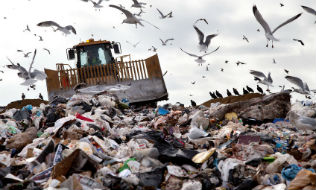

On a global scale, regulatory rumblings are growing louder on single-use plastics, highlighting potential risks and opportunities within the plastics supply chain for institutional investors to consider, according to a recent report by Schroder Investment Management Ltd.
As plastics move from being an “ecological concern to economic driver,” the report seeks to identify some of the investment risks for various sectors as public sentiment, government policy and new technologies all come into play.
“We started by looking at the natural capital cost that plastic packaging generates,” says Elly Irving, a sustainable investment analyst at Schroders in London, England. Natural capital includes carbon emissions, water consumption, the life cycle of plastics and any other environmental concerns associated with the material and its ensuing products, she notes.
Read: OMERS, Berkshire to sell Husky Injection Molding for $4.9 billion
When it comes to the portfolios of Canada’s largest pension funds, the Ontario Municipal Employees Retirement System sold plastics firm Husky IMS International Ltd. in late 2017. However, pension plans can have exposure in more tenuous ways than a straightforward manufacturer of plastics. The Canada Pension Plan Investment Board, for instance, held $3 million in beverage company Cott Corp., $17 million in packaging company CCL Industries Inc. and US$73 million in chemical manufacturer the 3M Co., among others, as of March, 31, 2017. All three companies fall within the sectors identified in Schroders’ report as having a potential material impact from plastics becoming less popular.
“We looked at the consumer companies and the regulatory trends and then we translated that back to packaging companies and then the chemical companies that are providing the raw materials to those packaging companies,” says Seema Suchak, a sustainable investment analyst at the firm.
For consumer-facing enterprises, “some companies will fair better than others,” notes Irving. “There are lots of consumer companies that already have recycling targets, that are already using recycled materials in their existing packaging, their light-weighting packaging, using alternative materials. So we think that some packaging would be exempt from a potential plastic tax.”
Read: How ESG considerations can lead to better investment decisions
The report notes Coca-Cola Ltd. made a commitment in January 2018 to collect and recycle the equivalent of all of its packaging in western Europe by 2030. Also in January, McDonald’s Corp. pledged to make all of its packaging either recyclable or renewable by 2025. These efforts won’t come without a cost, however, with retooling equipment, more expensive materials and the reconfiguring of supply chains adding to potential expenses, according to the report. Early adopters of those changes have the potential to benefit from lower packaging use, improved consumer perceptions of their brands and reduced risk of getting caught up in regulatory issues. Notably, the report identifies soft drink companies as the most vulnerable.
“Some business have a more business-as-usual approach and haven’t benefited from any of those costs savings or address the environmental risks with their packaging,” says Irving. “So even within sectors, we’ve seen a broad gap between those leaders and laggards.”
Businesses that manufacture the packaging materials themselves also face risks, with 37 per cent of consumer packaging currently made of plastic, according to the report, which noted efforts to innovate and develop sustainable alternatives will burnish companies as the world pivots away from traditional plastic. However, the report suggested the industry is moving too slowly for it to escape downside risks entirely. And while companies looking to be leaders in innovation will fare the best, those lagging behind could see up to a third of their earnings put at risk.
Read: Is gun control the next big ESG issue for institutional investors?
For chemical companies, bioplastics — plastics made of renewable materials such as corn starch or vegetable oils — are a potential area for growth. The report estimated the market will see 30 per cent compound annual growth between 2013 and 2030, whereas it expects traditional fossil-based plastics to grow much more slowly.
“Because the chemicals industry is so diverse, it becomes quite difficult to track down those specific plastics that are at risk of phase out to the chemical companies that provide them,” says Suchak, noting that increasing pressure from consumers will spur the production of such alternatives, which face challenges due to higher costs.
Waste management and recycling are also key enterprises when it comes to plastics, with the report pointing to China’s import ban on waste, which took effect on Jan. 1, 2018, as a major upheaval in the industry. The country reached an import peak of nine million tonnes of plastic every year in 2012, according to Greenpeace. China now has the world scrambling to find alternatives for its waste exports. While the industry is facing that challenge, there are opportunities in new locations, applications and products, the report noted.
Read: Ontario Teachers’ part of recapitalization of GFL
In particular, the diversity of materials that require recycling is a challenge for the industry, says Suchak, especially as newer packaging and bioplastics emerge. “You end up with this monster for recycling,” she notes, adding that a compostable coffee cup needs a completely different recycling facility than a regular one.
